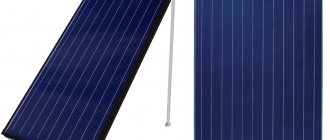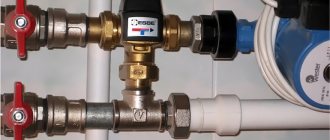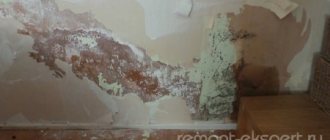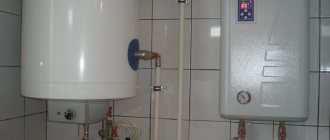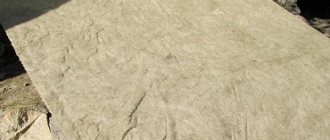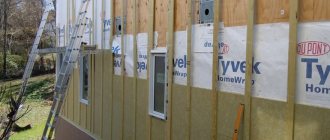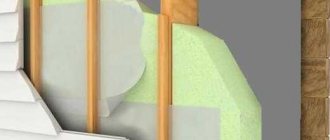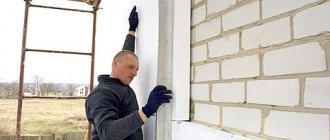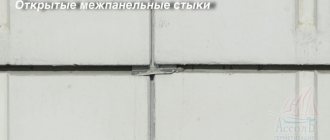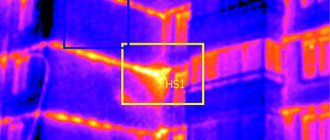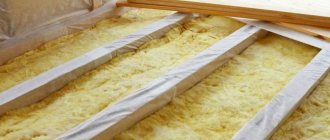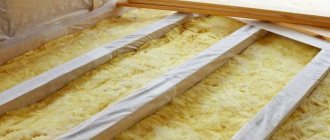Why is it cold in a panel house?
During the cold season, standard heating in panel houses may not be enough.
Even installing plastic windows instead of old ones, or replacing the radiator will not solve the problem. The largest amount of heat, in this case, escapes through the thin walls and open space of the balcony. To make living in an apartment more comfortable in winter, you can insulate the walls, but this is quite difficult. The best option would be to insulate a balcony in a panel house. First of all, the balcony needs to be glazed; it will be difficult to do this on your own; the smartest thing to do is contact a special company, of which there are many now. You will also have to seek help if the balcony is on a high floor, for external finishing and strengthening of the slab. But the internal insulation of the balcony after glazing can be done without outside help. In this article we will look at various methods of insulating a balcony and finishing methods.
Additional thermal insulation will help retain heat in the apartment, avoid drafts, and increase the overall temperature in the house without even replacing the batteries. Your stay will immediately become more comfortable. Insulation is a fairly feasible task for any person, even those without experience in repairing and furnishing an apartment. You just need to decide on the price and quality of the material and study the instructions. And every thrifty owner most often has the necessary tool for this.
Selection of material for insulation
After completing the glazing work, it is necessary to begin insulating the ceiling, walls and floor of the loggia. Before this, you need to decide on the choice of materials. Today, the technology for laying various options is almost the same, since modern materials have similar shapes and structures.
The most popular materials for insulating a loggia in a panel house are:
Most professional builders and craftsmen advise giving preference to penoplex, despite the fact that it is somewhat more expensive than the other two options. Its production is carried out using new technology, which makes the material the owner of:
- low level of thermal conductivity;
- long service life;
- ease of installation.
If your budget is limited, you can choose other materials, such as polystyrene foam. To insulate the ceiling, we choose penofol. The walls are insulated with foam plastic, the thickness of which does not exceed 7.5 centimeters.
Where to start and which method to choose?
First of all, it is necessary to glaze the loggia. It comes in two types - cold and warm. Cold, as the name suggests, only protects from rain and wind, but it won’t get any warmer on the balcony itself. It is better to glaze the balcony with metal-plastic windows, then you will be able to install heating there and use the additional space to your advantage, as a room for relaxation or storage. But after glazing, in order to prevent the structure from cooling, it is necessary to insulate the slabs themselves, because concrete has low thermal insulation properties.
There are many different materials for insulation. The most popular are polystyrene foam and mineral wool. You can additionally put expanded clay on the floor. To make staying on a new, warm balcony more enjoyable, you also need to complete the interior decoration. It will not only please the eye, but will also additionally protect the insulation from physical impact or moisture penetration inside.
Thermal insulators used to insulate loggias
Currently, construction stores offer a wide range of insulating materials, from which it is not difficult to choose the one that is right for you. You should focus on the climate and the proposed insulation scheme.
Mineral wool
The most tested and traditional material. It is constantly being modernized, has many shapes, which makes it very convenient for insulation, and today it is one of the most popular and effective.
Popular insulation - mineral wool
Depending on the source material, there are the following types of mineral wool: glass, stone and slag. It is available in various types and forms, in rolls and mats with a thickness of 20 to 200 mm. It is very plastic, convenient and easy to cut with a regular construction knife.
Expert opinion
Konstantin Alexandrovich
It has excellent heat and sound insulation properties and resistance to high temperatures.
The most important thing when working with this material is to protect yourself from separated microparticles. Glass wool is especially dangerous, since its invisible particles cause severe irritation and itching on the skin and mucous membranes. Be sure to protect your skin, eyes and respiratory tract before starting work. Of all the varieties, it is better to choose basalt wool - it is less harmful.
Foamed polystyrene (foam)
Polystyrene foam is easy to install on flat surfaces, is relatively cheap, has good thermal insulation properties, and is therefore often used to insulate balconies.
Its cellular structure retains heat well and does not allow sound to pass through, since the partitions between the cells dampen heat transfer and sound vibrations.
Available in a variety of options, varying in thickness - from 20 to 200 mm and density - from 15 to 50 kg/cub.m. The density of the foam should be selected based on need. If it is covered on top with additional plywood or other strong material, then you can take a lower density, since the higher the density of the foam, the worse it retains heat.
High-density polystyrene is stronger and easier to install and secure. It will help smooth out the unevenness of the walls, and not just insulate them. But the best option for leveling is extruded polystyrene foam.
Extruded polystyrene foam
Extruded or extruded polystyrene foam and polystyrene foam, although they consist of the same substance, differ in the technology for creating granules. At elevated temperatures, the granules are mixed and squeezed out of the extruder, due to this a uniform, closed-porous structure is formed, which has a high density.
Choice of insulation
Many people believe that glazing the loggia space is not necessary. However, it is important to understand that the balcony is often blown from both sides, and in winter it is very cool from the inside and outside. Why is it necessary to carry out insulation:
- In most cases, balconies protrude beyond the frame of a residential building, so air flows from all open sides, which cools the walls.
- With the help of insulation, you can avoid drafts and discomfort, and also create a pleasant microclimate in the apartment.
- Thermal insulation will help raise the temperature in the room, this is especially true for the bedroom or nursery.
- The heat will be retained inside your apartment for a long time, since cold air will stop flowing.
- You won’t have to use the heater often, which will save money on electricity.
- Concrete is a poor thermal insulator, so it allows cool air to pass through well. In addition, this way the structures cool down quite quickly.
- After installing insulation materials, the balcony will become a real living room.
Related article: Balcony shelving with doors
Balcony insulation scheme
To understand how to insulate a balcony from the inside with your own hands in a panel house, you need to understand the features and types of materials. The most popular insulation materials are: mineral wool and polystyrene foam for walls, as well as expanded clay for flooring. It is worth noting that heating of balcony slabs should be carried out only after glazing. How to choose material and means for heat insulation:
- Choosing glazing. To isolate cold air, several types of window structures are used:
- Wooden frames. They do not solve insulation problems well and require additional specific care due to the characteristics of the material.
- Aluminum windows. Designed for cold glazing, as they do not retain warm air well. Such frames can only save you from strong winds and heavy rainfall. However, their light weight and affordable prices are very attractive to consumers.
- Made of metal-plastic. Such windows are considered the most expensive option; they are resistant to sudden temperature changes and have heat and sound insulating properties. As a rule, these are windows with a 5 or 6-chamber profile and two-chamber glazing. The metal-plastic profile is durable, but has a lot of weight, which can become an obstacle to installation on a balcony slab. How to insulate a balcony from the inside with your own hands in a panel house is shown in the video below.
- Choosing insulation for balcony slabs. Once you have finished with the glazing, you can proceed to the main stage of the work process, namely insulating the balcony slabs from the inside. First, let's figure out what properties the material should have:
- Environmentally friendly and safe for health (insulation should not emit toxic substances).
- Good thermal conductivity.
- Waterproof.
- Long service life due to its durability.
- Fire resistance (the material should not emit acrid smoke when burning).
- Vapor-repellent properties.
Loggia insulation scheme
All materials can be used for floors, ceilings and walls, but during installation it is worth taking into account their features and technical characteristics. The most popular of them are:
- Penofol. How to insulate a balcony from the inside with your own hands in a panel house with penofol is shown in the photo. It is excellent insulation and can reflect ultraviolet rays. It consists of layers of polyethylene foam and a layer of aluminum foil. It is valued not only for its ability to reflect the sun and heat, but also for its light weight, ease of installation and affordable price. It also protects not only from electromagnetic radiation, steam, humidity and steam condensates, but also from certain types of radiation. It can be found in rolls in stores.
Preparing the premises for insulation work
Before choosing insulation, you need to decide on the thermal insulation technology, but first of all you need to prepare the balcony for repair, since the preparation is the same in any case, no matter what method you choose.
Do not ignore preliminary procedures and do not skimp on them so that the insulation is of high quality and does not have to be redone in a few years. Proper preparation is necessary to prevent moisture from getting under the insulation, causing it to begin to deteriorate, lose the qualities for which you chose it, and become ineffective.
The algorithm for preparing surfaces for insulation is as follows:
- First, thoroughly clean the walls, ceiling and floor of old paint, various concrete irregularities, bumps, etc. Crushed, breaking concrete must be eliminated to a smooth surface.
- Then the floor is carefully cleaned until it is absolutely clean. Large debris can be collected by hand, but dust must be sucked up with a vacuum cleaner to detect various cracks in walls and slabs.
Now you can start sealing holes, crevices and holes
- Cracks visible to the eye are expanded, cleaned, if necessary, moistened with water and filled with cement mortar or sealant.
- The gaps between the plates also need to be enlarged, moistened with water and filled with foam.
- In addition to the damage listed above, cracks, dents, and small potholes may form in the concrete. They will not interfere with fixing the base evenly, but when the temperature changes, condensation may accumulate in them. Therefore, they need to be leveled; this can be done using cement mortar with the addition of PVA glue.
After all the covered defects have dried, you need to cut off the excess foam and remove the remaining sealant. Afterwards, it is necessary to prime all surfaces to protect against mold and strengthen the surface.
Surface waterproofing
At the next stage, you need to protect the floor and lower part of the walls from water. The walls must be waterproofed to the height of the final floor installation.
There are several main methods of waterproofing:
- Covering the floor with roll materials that do not allow moisture to pass through, for example roofing felt, which is hot glued onto bitumen mastic. Currently, there are roofing felt with a prepared glued mastic layer, which is heated with a burner.
- Penetrating waterproofing is a special composition for impregnating concrete. If you are going to lay tiles on the floor, then this method is not suitable. The effect of such protection against moisture is based on the fact that it penetrates the cellular structure of concrete and forms crystals that fill the pores of the material from the inside. The crystals become part of the concrete, compacting its structure and preventing water penetration. Since the composition is very toxic, it must be applied extremely carefully, protecting exposed skin, otherwise you may get burned.
- For tiles, it is recommended to use liquid rubber - a two-component mastic that is cold applied and quickly hardens. It is applied with a roller or wide brush. As liquid rubber hardens, it forms a kind of thin, moisture-proof film on the floor and walls.
- Waterproof plaster mixture, which is applied with a wide brush, or, if necessary, with a spatula of a suitable size.
- An inexpensive method is thick oil paint, which is easy to apply and hides minor flaws, but is quickly absorbed by concrete, which increases its consumption
- A time-tested method is to cover the floor with thick plastic film, making sure that it completely covers the height of the future floor and fits correctly in the corners. The film should form something like a bowl that will protect the insulation. Secure it with construction tape or liquid nails.
You can choose any method based on your preferences and budget. All of them perform their main function - they do not allow water to penetrate into the room, and therefore reduce the likelihood of black mold, which is very difficult to fight.
Ceiling insulation
The ceiling can be insulated in various ways, it depends on the choice of insulation. But the best option for a substrate under the sheathing and a layer of the main thermal insulation material is to fix a thin layer of foil polyethylene foam on the entire surface of the ceiling.
Foil backing for sheathing
It is mounted on construction tape with two adhesive sides or on universal Moment adhesive, which is evenly distributed over the ceiling in small dots and the insulation is pressed against it. It is best to use sheets for this purpose that need to be bent onto the walls by approximately 150-200 mm for additional waterproofing of the joints. Check that the insulation is securely fastened, as the sheathing will be installed on it.
The sheathing can be made either from a galvanized metal profile for plasterboard, or from a wooden beam - both are suitable for laying mineral wool or polystyrene foam.
The distance between the fastenings of the sheathing elements depends on the width of the insulation; it is desirable that it be close together, without gaps. Since mineral wool is elastic, this interval can be reduced by 30-50 mm for a good tight installation.
Laying insulation in sheathing cells
At the next stage we lay the insulation. The mineral wool will become tight between the beams, especially if you followed the advice and shortened the interval, but polystyrene foam is a hard material, so small gaps may remain. To prevent the penetration of cold, they need to be filled with polyurethane foam, the protruding parts of which will need to be cut off after drying.
Ceiling insulation with foam plastic
Along the sheathing guides, the material is covered with clapboard or plasterboard sheets.
Since foam boards are durable, they can be attached directly to a concrete ceiling.
Installation of slabs directly on the ceiling
Installation is carried out using special plastic mushrooms. For them, holes are drilled in the concrete directly through the insulation, into which the fungus is inserted, and then a plastic nail is carefully driven in.
Do-it-yourself insulation of a balcony with mineral wool
Insulation with mineral wool is especially popular. The work can be done in-house.
This is done in the following sequence:
1. The frame is mounted. A beam measuring 50 by 50 cm is attached to the insulated surface. The distance between the elements is consistent with the size of the slabs being laid. It should be 10 - 20 mm less than the corresponding geometric parameter. The frame can be vertical or horizontal. The optimal location of the sheathing is selected taking into account the subsequent finishing. The position of each element is controlled using a level.
2. Mineral wool slabs are laid between the frame posts without additional fastening. If necessary, the insulation is cut to size using a construction knife.
3. A beam is attached to the frame posts on top, which is placed perpendicular to the previously fixed elements. It is attached with a similar step. Mineral wool slabs are laid perpendicular to those laid earlier.
4. A vapor barrier is attached to the top of the frame using a construction stapler. All joints of the vapor barrier material are taped using double-sided tape. The individual elements are connected with an overlap of at least 100 mm. In places adjacent to the window, walls and ceiling, vapor barrier is used using a special sealing tape.
5. The counter-lattice is installed. The pitch and spatial position are selected taking into account the subsequent finishing. The facing material is attached to the counter-lattice.
Source https://www.youtube.com/watch?v=G7rZmJG-L38
Insulating the loggia floor
To insulate the floor, you can also choose various options: dry screed, lifting with joists, or simply covering the concrete floor with extruded polystyrene foam. The latter action is not effective in maintaining the temperature on the balcony as in the rooms, it will simply make the floor not too cold.
Expert opinion
Konstantin Alexandrovich
The most highly effective and most frequently used method is insulation using logs.
The joists can be laid directly on the concrete floor or adjusted in height using various devices - metal holders, studs, adjustable or homemade stands.
Metal holders raise the guides, and this is a good way to attach joists if they are high enough to install insulation. For a standard loggia (size 3*1.2 m), three rows of logs will be enough.
The holders are attached to concrete and insulation is put on each. Mineral wool is most often used in combination with such fastenings. A square is cut from it, in which two holes are made, through which the insulation is put on the rack.
Having secured the logs in the holders and checked the horizontality, we lay the main insulation over the entire floor area. To achieve a better effect, place another layer of mineral wool, almost to the level of the joists.
Using staples, secure the vapor barrier film on top of the insulation to the joists.
The logs are covered with 10 mm thick plywood on top, and all cracks and crevices are filled with polyurethane foam. After drying, the excess foam is cut off, and a decorative coating is laid on top of the plywood.
- If the floor on the balcony is not too level, and you don’t want to bother with a leveling screed, then metal or plastic height-adjustable stands would be a good option. With their help, it will not be difficult to lay out the logs strictly horizontally. The logs are placed and secured onto the stands, and only then are they lowered to the floor and leveled. The rest of the installation, including laying insulation and decorative coating, is carried out in the same way as with metal holders.
- You can also set up the logs using paving sheathing prepared on your own, installed on stands made of the same wooden blocks to the required level. If the field is not very level, you will have to tinker with such a design to align it horizontally. Such a sheathing must certainly be attached to the walls of the loggia.
- If you do not plan to use the balcony as a living space, but simply want to raise the temperature there so as not to let cold air into the apartment, then raising the floor to the threshold level is not required. It will be enough to lay the insulation to the height of the logs, fixed to thin polyethylene foam laid on concrete.
Under these conditions, the joists are drilled through and secured using anchors. The space along the walls and between the joists is filled with insulation and covered with a vapor barrier and plywood.
Loggia heating
The actual insulation of the loggia is completed; however, if you want to make it truly cozy, it is advisable to install heating devices in it and connect them to the riser.
Materials
Let's start with the choice of materials.
- The central heating system is characterized by some unpredictability of parameters. It is possible that the design coolant temperature may exceed the design temperature and, more importantly, water hammer. Opening the valve too sharply can lead to a pressure jump at the flow front up to 20-25 kgf/cm2. Hence the obvious requirement: heating devices must have a large margin of safety. The optimal choice is bimetallic radiators; Steel convectors can be a budget solution.
- The best pipes for our case are corrugated stainless steel. They combine the highest strength with ease of installation, eliminating the need for welding.
The material is durable, flexible and easy to install with the simplest tools.
Installation Tips
It is difficult to describe the whole process step by step: it depends on the configuration of the liner, the location of the risers and a number of other factors.
However, a number of tips can be given.
- To pass pipes through the wall separating the loggia from the room, take a hammer drill with a diameter two millimeters larger than the pipes. It is better to drill from the loggia; It is advisable to go through wall panels and foam plastic with a ballerina.
- Radiators or convectors are placed on brackets for floor installation. The top of the heating devices is attached to the wall only so that they do not damage the liner during lateral loading.
- The connection to the connection to the room radiator is serial, not parallel.
The optimal connection is: - The lower supply is disconnected from the radiator in the room and led to the loggia by a corrugated pipe.
- The end of the radiator with the hose disconnected is plugged with a blind plug.
- Instead of a blind bottom plug, a walk-through plug is installed at the opposite end of the heating device, to which the return supply for heating the loggia is connected.
- Heating devices on the loggia are connected in series.
Optimal connection diagram for one radiator on a loggia.
Insulation of loggia walls
Insulation of walls is done in the same way as on the floor or ceiling of the loggia. Here, too, you can choose a method to suit your taste - use wooden or metal sheathing or rigid insulation, which is attached to the walls with special glue or polyurethane foam.
- Installation of penoplex will be easy if you prepare the panels of the required size in advance. All vertical surfaces are faced in the same way - we apply glue to the back of the insulation and press it firmly to the wall. For additional fastening, you can fix the panels using plastic mushrooms.
But still, a more popular option, which is suitable for any thermal insulation material, is a method using lathing walls with wooden beams or metal profiles.
Before installing the sheathing, to increase efficiency, it is recommended to make a polyethylene foam backing with a foil surface.
- Such a substrate will create a “thermos” effect and will reliably retain heat on the loggia. Next, the sheathing is fixed on top. The guides should be placed at a distance equal to the width or length of the insulation mats.
Installation of sheathing
The selected heat insulator is laid - polystyrene foam or mineral wool; it is covered on top with a vapor barrier film, secured with staples on bars or, when using metal guides, with liquid nails along the upper and lower edges.
Foam insulation
Insulation with mineral wool
And finally, the final stage is covering with decorative material, such as clapboard, or plasterboard for painting or plaster.
Insulation with polyurethane foam
The most modern method of insulation is spraying polyurethane foam. In most cases, it is practiced for insulating the inside of roofs and outside walls in private houses and cottages, but since this method is characterized by speed and ease of installation, it is increasingly used on balconies and loggias in city apartments.
The only thing is that this method cannot be carried out independently; spraying is carried out only by professional specialized companies using special equipment.
Before entrusting your loggia to professionals, it is necessary to make additional preparations in the room, that is, make lathing, as described in the article above. The lathing will serve as a frame for the heat insulator and fastening on top of the decorative trim.
The great advantage of this method is that when sprayed, polyurethane foam expands and fills the entire space without leaving any gaps. It can be used not only on walls, but also on floors and ceilings. The surface becomes completely windproof, that is, it retains heat perfectly. Plus, you are spared the need to carry out additional inspection and fill cracks and cracks with polyurethane foam; you can immediately begin finishing.
Materials used for insulating floors on balconies and loggias
Before starting work on insulating the floor on the balcony, you need to select the type of material for thermal insulation. The technological process and the choice of additional tools and parts directly depend on this.
Floor insulation with penofol
The following types of materials are used:
- Penofol is a roll insulation consisting of layers of foamed polyethylene and reflective foil. It is quite thin, used mainly as an additional element in combination with other insulating materials;
- Polystyrene foam is a well-known building material, rigid, and retains heat well. It comes in different densities and thicknesses, which allows you to use it economically, and the installation technology is quite affordable;
- Expanded polystyrene is foamed plastic, the second name is penoplex. Compared to conventional foam, it has an increased density, smaller pores, and a ridge profile, which eliminates the occurrence of cold bridges. This is the most expensive insulation compared to others;
- Mineral wool is a soft insulation that cannot hold its shape. When using mineral wool, it is necessary to make lathing with logs. A significant advantage is that small gaps can be filled with such insulation. Available in roll packs or in the form of mats. Before working with mineral wool, it is necessary to glaze the balcony, since it is a hygroscopic material.
- Expanded clay is a bulk heat insulator. It has obvious advantages - environmental friendliness, non-flammability. Produced in granules of various sizes, it is used as filling the space between joists, for mixing mortar for ceramic concrete screed.
Floor insulation with mineral wool
Loggia design solutions
Let's see how we can use the additional space resulting from insulating the loggia. In practice, you have one more room at your complete disposal, and only you can decide what it will be like.
For our part, we can offer several ideas on how to use the new opportunities.
The warmest transformation - the loggia turns into a cozy little corner for relaxation. Here you can enjoy the silence with a good book or crafts. If necessary, there is enough space to install a TV or a small table for a laptop.
If a large family lives in an apartment, it is sometimes difficult to find a comfortable, quiet place for your favorite activity. Despite the small space, your new insulated loggia will allow you to place even two separate corners for activities dear to your heart. For example, a cozy deep chair can be placed in one corner, and a small table for a laptop in the second.
A very stylish modern option, suitable if the exit to the balcony is from the kitchen. You can even transform the loggia into a kind of dining room.
Ideal for parties, especially in the case of high floors and an attractive view from the window, a window sill can easily replace a bar counter.
Using small details, such as lit candles, you can create the atmosphere for a romantic dinner. Fresh fragrant air and watching the sunset on warm summer days, and in winter - cozy blankets, candles and mulled wine.
If you install glass sliding doors instead of standard ones, you can delimit the space if necessary.
A bold design solution suggests expanding the living room space onto the loggia. The wall that previously separated the rooms has been turned into a comfortable table.
In this case, the area of the former loggia can be used as a study or hobby room.
By combining two spaces, the living room provides access to a large window, which increases illumination; you will feel this well in winter, when there is always not enough light.
It is not difficult to come up with the use of additional warm space, everything is limited only by your flight of imagination. A winter garden, a workshop, an office, even a sports corner - everything is doable.
Therefore, if your apartment has a loggia, and you still haven’t thought about insulating it, get down to business immediately.
